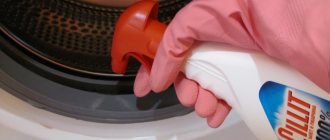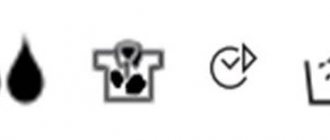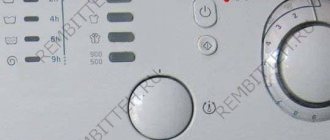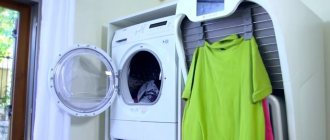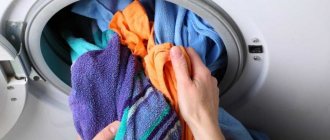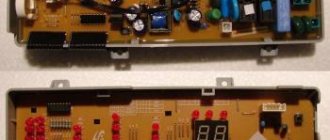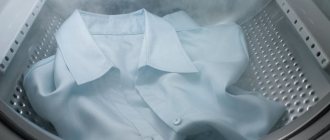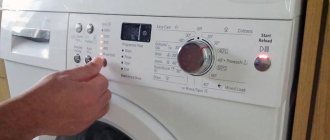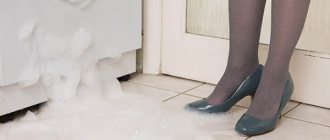If water remains in the detergent dispenser
A little water in the conditioner compartment after washing is normal, nothing needs to be done. It’s a completely different matter if the rinse aid compartment is full of water after washing or water remains in the powder compartment. Here you need to find out what the reason is and eliminate it, fortunately, in most cases this can be done on your own. Below is a list of reasons why water may remain in the detergent dispenser:
- Improper care of the detergent tray. Washing machine manufacturers recommend regularly washing the hopper to remove any residual detergent. If you forgot about this recommendation, the tray may have become clogged; it needs to be removed and thoroughly rinsed with water.
- The car is not level. If the washing machine is installed tilted forward, water may remain in the conditioner compartment. It is necessary to study the user manual and install the unit strictly at level.
- Poor quality detergents (powder, conditioner, etc.). Perhaps the reason is a low-quality washing powder or rinse aid, which has clogged the holes in the dispenser grid of the washing machine. Rinse the tray with running water, and next time try using a different brand of detergent.
- Too much washing powder. Perhaps you pour too much washing powder into the machine tray, it clogs the flush, hence the water in the powder compartment after washing. Try reducing the amount (check the machine manufacturer's recommendations for the amount of washing powder).
- Weak pressure in the water supply. As a result, the powder and/or conditioner are not completely flushed out of the compartment and clog the holes in the dispenser. In this case, water and detergent remain in the tray. Check whether the water supply valve to the washing machine is fully open. If so, then this is probably the reason for the low pressure.
Causes of water accumulation
For what exact reason can water accumulate in the drum of a washing machine? After all, current washing devices are protected against leaks.
Everything is done so that water cannot leak out and cause a flood. There are also washers with check valves if you don't have access to your machine.
And yet, even with safety (and prevention) measures taken, water may continue to appear.
It is important to identify the primary source of water entering the washing machine drum during rest.
Let's analyze and find out what color the water in the machine is?
- With dirty water and sewer stench, we have a sewer problem.
- If the water is not dirty and does not stink, there are problems with the plumbing and some minor problems in the device itself.
If the machine is not connected according to the rules, then, of course, problems will arise with the sewerage system, and the water drainage will stop functioning.
This, as a matter of course, begins to cause the appearance of water in the tank, plus several more malfunctions discovered by chance add to the trouble. Let's look at a few specific examples of how water appears in the drum of a washing machine.
Water from a non-working washing machine
Let's say: the machine is not in use, but there is still water in the device and does not pass through. First you need to turn off the water tap.
If, thanks to this action, the problem was not solved, then the issue will be in the unreal functioning of the water drain. Quite often it happens that water from the drain gets into the machine .
The reason for such a mistake is the inaccurate location of the connection to the sewer system. This means that you should look at the device connection again.
If everything is done properly, then the source of the problem is most likely a blockage inside the device itself.
Everything that flows from the sewer will collect inside the machine, and not finding a way out, will rise through the hose. But what to do? We need to get rid of this kind of blockage.
If the water in the washing machine tank does not go away, then you may have to completely disassemble your washing machine. There is also the option of a faulty shut-off input . But why might this happen?
- If the water used for washing is of poor quality, then it may contain gravel and some other small stones. The result will be valve clogging and complete failure.
- There is a possibility of valve wear. Everything is much simpler here, because this can be solved by a simple replacement.
In addition, in such a situation there is also room for a wiring fault , which also affects the valve. To diagnose, contact the specialists from the service centers for purchasing your equipment - they will be able to identify the broken part and carefully repair everything.
If you cannot fully rely on yourself, then you should still turn off the water tap and call a specialist.
The appearance of water in the tank during operation of the device
If the water does not drain completely or remains only in the pan of the machine, then the problem may lie in the SMA.
Drain filter clogged
This is a staged situation: you washed, and after the spin cycle there was still water left. In order to eliminate this problem, you need to monitor the drain system and filter from time to time.
The most popular reason for water appearing in a washing machine is a clogged drain filter . We do everything according to the following plan:
We manually drain all the water from the hose - otherwise there is a risk of liquid spilling onto the floor.- We unscrew the filter and actively rinse it with tap water.
- Let's look at the pump located behind the filter: turn on the drain mode and see if the pump blades rotate.
- If dirt is clogged in the pump, then clean this area as well.
- Put everything back and turn on the drain program again. If everything started to work correctly, then the reason lay in a contaminated drain.
Broken pump
If you disassembled the filter and pumps to check for dirt, but this did not give visible results, then the breakdown may be much more serious than we expected.
If the washer still tries to drain the liquid and makes too much noise, then most likely it is time for a major overhaul of the pump. How to check for her incapacity?
If the pump impeller does not move when draining, then it is the reason for poor performance.
In this case, independent repair is almost impossible, so it is better to call a specialist. In 90% of cases, the problem of a broken part is solved by purchasing a new one and replacing it at home.
You can buy a new pump yourself or by asking the service center employees to choose the one you need. They will be able to give advice on where to purchase the pump model that is right for you.
If the washing machine does not finish washing and there is water left in the drum
First, check which wash program you have selected. Many washing machine models have a water-stop wash cycle (for delicates or woolen fabrics). Perhaps you have washed using such a program? Then just turn on the drain mode.
If the machine does not drain and there is still water in the tank, most likely the pump is faulty. You can learn more about other possible malfunctions and how to eliminate them from the article “Wet case: the washing machine does not drain water.”
Call the workshop "RemBytTech"
If you are not sure that you can cope with the problem yourself when a switched-off washing machine fills with water, call the RemBytTech workshop
7 (495) 215 – 14 – 41
7 (903) 722 – 17 – 03
and entrust the repair to professional craftsmen.
- telephone consultation;
- qualified craftsmen;
- repairs at your home within 24 hours after your request;
- free diagnostics (if the repair is carried out by our technician);
- Warranty up to 2 years on all spare parts and work performed.
or via online application.
Within 24 hours after receiving your application, a qualified technician will come to your home and return your washing machine to its former performance.
Water appears in a non-working machine
When the liquid in the drum of the device arrives and the machine is in a non-working position, the aquastop system does not work, since the sensor is located in the pan near the floor. All the liquid pours out.
The device fills with liquid if:
- the supply or siphon valve is broken;
- there is no siphon valve at all;
- The drain system is clogged, and all the drainage ends up in the drum instead of the sewer.
To fix the breakdown, you need to turn off the tap through which water flows and disconnect the equipment from the electricity.
Read more ► Do-it-yourself Indesit washing machine repair, troubleshooting common faults
If the drum still fills with liquid, you need to carefully check the connection of the unit. If the drain hose is not connected correctly, the tank of the machine will fill with sewage.
If everything is connected according to the instructions, the reason for the appearance of liquid may be the accumulation of a blockage inside the pipe. Sewage will begin to collect inside the machine.
And since they will have nowhere to go, everything will go down the drain. To fix this, you need to clear the clog.
Inlet valve fault
Malfunction of the inlet valve
Liquid penetration into the drum occurs through a cracked membrane, which is damaged during operation of the device. The membrane inlet channel does not close due to a contaminated area.
A clog creates a favorable environment for the development of microbes and unpleasant odors. To diagnose the problem, turn off the supply valve. If it stops flowing into the drum, then it is necessary to replace the valve with a new one.
For this:
- Close the valve and disconnect the cable.
- Before removing the valve, the hoses are disconnected from the nozzles.
- Instead of the old valve, a new one is inserted.
Fault prevention
Recently, service center technicians have noted that breakdowns of drain pumps in new washing machines have become more frequent and occur already after 2-3 years of use. This may be due to low-quality components, or possibly due to the installation of the machine, when the drain hose is significantly extended, thereby increasing the load on the drain pump. That is why we draw your attention to the fact that you must follow the manufacturer's installation recommendations.
In most cases, problems with blockages can also be avoided if you adhere to the following rules:
- Before washing, check the pockets of items for debris and foreign objects;
- wash the drainage filter regularly;
- Clean the washing machine, for example, using citric acid or special products.
So, the water remaining in the drum after washing is a sign of some kind of malfunction that must be resolved immediately. If you start looking for the cause, and even more so you are afraid of repairing the machine, then at least before the technician arrives, you need to drain the water from the washing machine. This will prevent the appearance of an unpleasant odor inside the tank. You can definitely handle this.

